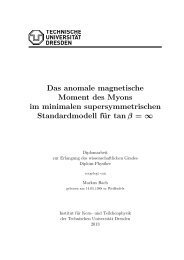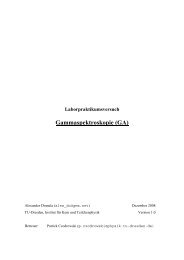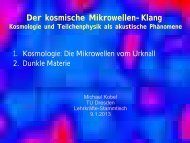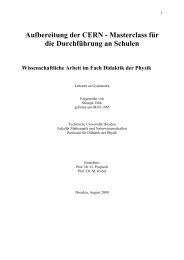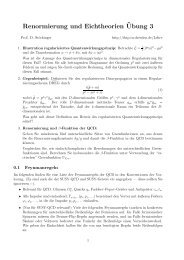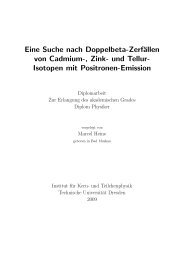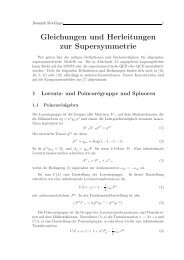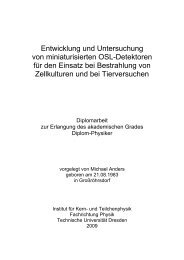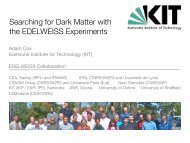a design study for a cobra upgrade to - Institut für Kern- und ...
a design study for a cobra upgrade to - Institut für Kern- und ...
a design study for a cobra upgrade to - Institut für Kern- und ...
You also want an ePaper? Increase the reach of your titles
YUMPU automatically turns print PDFs into web optimized ePapers that Google loves.
4.2 Detec<strong>to</strong>r assembly 43<br />
secondary electrons are accelerated <strong>to</strong> the second dynode and so on.<br />
PMTs have typically 9 <strong>to</strong> 16 dynodes and an overall multiplication fac<strong>to</strong>r<br />
(gain) of 10 6 up <strong>to</strong> 10 9 . The final electron pulse is collected at the<br />
anode and has a time delay of 20-50 ns and a width of a few nanoseconds.<br />
The detection of single pho<strong>to</strong>ns is possible. The Hamamatsu<br />
PMT R669 shows a temperature coefficient of -0.3 %/K at 550 nm [39].<br />
The time resolution of a PMT is mainly determined by the escape velocity<br />
of the pho<strong>to</strong>electron and the distance between the emission point<br />
and the hitting point at the first dynode. It is typically below one ns<br />
[28, 29, 30].<br />
PIN diodes consist of a p-doped primary material that is heavily<br />
n-doped on one surface. A controlled diffusion of the dona<strong>to</strong>r a<strong>to</strong>ms<br />
leads <strong>to</strong> a n-doped layer at the surface and an internal i-region, with<br />
nearly intrinsic properties. There the number of accep<strong>to</strong>r and dona<strong>to</strong>r<br />
a<strong>to</strong>ms is identical and the specific resistance of 10 5 Ωcm corresponds<br />
<strong>to</strong> the intrinsic resistance of silicon. The depletion zone must be thick<br />
enough so that incident particles can create enough ionisation in the<br />
sensitive region <strong>to</strong> <strong>for</strong>m a larger signal than the noise level. The<br />
thickness of the depletion zone is limited <strong>to</strong> 10 <strong>to</strong> 15 mm and is much<br />
bigger than that of diodes with pn-junction. This is suitable <strong>for</strong> beta<br />
or low-energy pho<strong>to</strong>n detection. The small p-layer of the diode is the<br />
entrance window. The incident ionising particles can produce direct<br />
or indirect electron hole pairs. Those are produced in the i-region and<br />
the induced charge is processed <strong>to</strong> an attached preamplifier <strong>to</strong> produce<br />
the output signal at the anode. With a required energy <strong>for</strong> excitation of<br />
3.6 eV in Silicon and 2.8 eV in Germanium, they are able <strong>to</strong> detect the<br />
typical scintillation light of 3-4 eV with a high quantum efficiency of<br />
60-80 %. Only in the best case, as much electron hole pairs as incident<br />
scintillation pho<strong>to</strong>ns are produces. These are typically just a few<br />
h<strong>und</strong>red. Without any multiplication process the signal is 8 orders of<br />
magnitude lower than that of PMTs. Electronic noise is a problem due<br />
<strong>to</strong> this very small signal. PIN diodes have a fac<strong>to</strong>r 2 worse resolution<br />
than PMTs and can compete only <strong>for</strong> high energetic particles [29]<br />
The temperature dependence of pho<strong>to</strong>diodes (Hamamatsu S2744-08)<br />
is very small with 0.01 %/K at 550 nm [39].<br />
The greater sensitive region leads <strong>to</strong> a greater thermal noise than normal<br />
diodes. Thus cooling is necessary <strong>to</strong> gain a high resolution. The<br />
dark noise can also be reduced by using materials with a larger band<br />
gap than silicon, like mercury iodide crystals. Such PIN diodes are superior<br />
<strong>to</strong> PMTs and achieve energy resolutions of 4.58 % with CsI:Tl<br />
scintilla<strong>to</strong>rs [28, 29, 30, 41].





